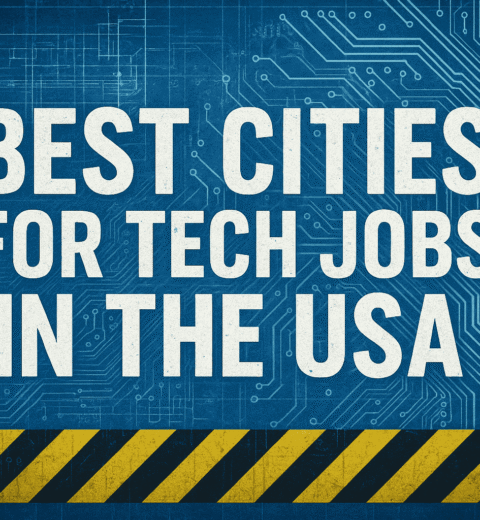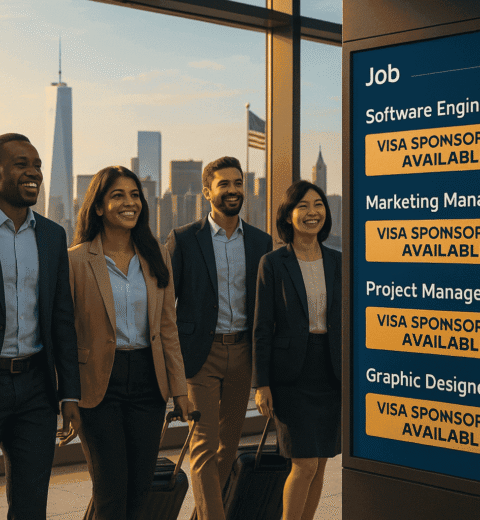Green Card Sponsorship Jobs in the USA 2025: Trends, Opportunities, and How to Secure Employment
Table of Contents
- Introduction
- Understanding Green Card Sponsorship Jobs
- Top Industries Offering Green Card Sponsorship in 2025
- Job Market Trends for Green Card Sponsorship in 2025
- How Employers Sponsor Green Cards
- Steps to Find Green Card Sponsorship Jobs in the USA
- Challenges and Solutions in Securing Sponsorship
- Alternative Visa Options for Jobs in the USA
- Conclusion
- FAQs
Introduction
For decades, the United States has stood as the land of opportunity for skilled professionals across the globe. With its dynamic economy, world-class innovation hubs, and diverse career pathways, America continues to attract top talent looking to build rewarding careers and stable futures. Among the most sought-after opportunities are green card sponsorship jobs in the USA, which provide foreign workers with permanent residency—a golden ticket to long-term success in one of the world’s strongest job markets.
As we look ahead to 2025, significant shifts are reshaping the employment landscape. Technology continues to dominate, healthcare demands are surging, and infrastructure development is creating new opportunities in engineering and construction. For international professionals, understanding these job market trends and knowing how to navigate the sponsorship process can make all the difference in turning American career aspirations into reality.
What This Guide Will Cover
This in-depth resource is designed to be your ultimate roadmap to securing green card sponsorship employment in the USA. We’ll explore:
- Which industries are actively sponsoring foreign workers in 2025—from booming tech sectors to critically understaffed healthcare fields?
- The latest job market trends influencing sponsorship opportunities and visa approvals
- Step-by-step strategies to improve your chances of finding an employer willing to sponsor your green card
- Alternative visa options if immediate green card sponsorship isn’t available
For those considering different pathways to U.S. employment, we’ve created detailed guides that complement this resource. You might find our article on How to Get a Work Visa for Jobs in the USA particularly helpful if you’re exploring temporary work options first. Similarly, tech professionals should review our specialized guide on Jobs in the USA for H1-B Visa Holders to understand competitive alternatives to permanent residency.
The Life-Changing Value of Green Card Sponsorship
Unlike temporary work visas that tie your residency to a specific employer, a green card offers unparalleled freedom and security. Imagine:
- Job flexibility to change employers without visa complications
- Pathway to citizenship after maintaining permanent residency
- Family benefits allowing you to sponsor relatives
- Long-term financial stability with access to better loans, mortgages, and business opportunities
This isn’t just about a job—it’s about fundamentally transforming your life trajectory. That’s why understanding the sponsorship landscape for 2025 is so critical. The rules are evolving, some industries are expanding their international hiring, and new policies could affect processing times.
In the following sections, we’ll break down everything you need to position yourself as a top candidate for these coveted sponsorship opportunities. From identifying the most sponsor-friendly employers to navigating complex immigration paperwork, consider this your masterclass in building an American future through skilled employment.
Understanding Green Card Sponsorship Jobs
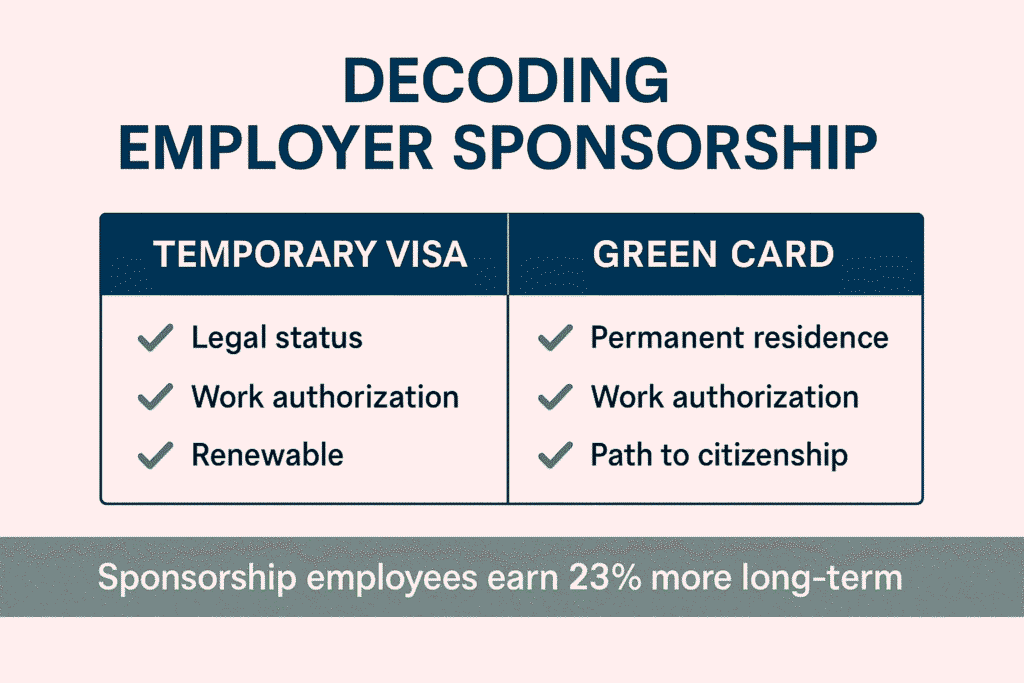
Green card sponsorship jobs represent a unique category of employment opportunities where U.S. companies go beyond typical hiring to actively support foreign workers in obtaining permanent residency status. Unlike temporary work visas like the H-1B that tie employees to specific employers and have expiration dates, these positions come with the extraordinary benefit of employer-sponsored permanent residency. This means successful applicants gain the right to live and work indefinitely in the United States, with the freedom to change jobs, start businesses, and build permanent lives in America.
The sponsorship process represents a significant commitment from employers, as they essentially vouch for the employee’s value to their organization and the broader U.S. economy. These opportunities are particularly valuable because they solve one of the biggest challenges skilled immigrants face—transitioning from temporary visa status to permanent residency without having to leave the country or face uncertain visa lotteries.
The Five Pathways to Employment-Based Permanent Residency
The U.S. immigration system offers several employment-based green card categories, each designed for different professional levels and circumstances:
EB-1: For Extraordinary Talent and Leadership
This premier category serves individuals who have reached the pinnacle of their fields. It’s divided into three groups:
- Those with extraordinary abilities in sciences, arts, education, business, or athletics (think Nobel Prize winners or Olympic athletes)
- Outstanding professors and researchers with international recognition
- Multinational executives and managers transferring to U.S. operations
What makes EB-1 particularly attractive is that it often bypasses the lengthy labor certification process required for other categories, potentially shortening the green card timeline significantly.
EB-2: Advanced Professionals and Exceptional Talent
The EB-2 category serves two distinct groups:
- Professionals holding advanced degrees (master’s or higher) or equivalent experience
- Individuals with exceptional ability in sciences, arts, or business who can demonstrate their contributions would substantially benefit the U.S.
Many technology and healthcare professionals qualify under this category, especially when their skills fill critical needs in the American job market.
EB-3: Skilled Workers, Professionals, and Essential Labor
This broader category encompasses three tiers of workers:
- competent employees who have received at least two years of specialized education or experience
- Professionals holding bachelor’s degrees
- Other employees doing unskilled work that is not seasonal or transitory
While EB-3 has more availability than EB-1 or EB-2, it also tends to have longer processing times due to higher demand.
EB-4: Special Immigrant Categories
This niche category covers specific roles, including
- Religious workers serving in ministerial or vocational capacities
- Certain broadcasters working for U.S. media outlets
- Employees of international organizations
- Other specially designated groups
The requirements here are very specific and apply to relatively small numbers of applicants each year.
EB-5: The Investor Visa Program
For those with significant capital to invest, the EB-5 program offers:
- A path to residency through investments of $800,000-$1,050,000 in U.S. businesses
- Requirements to create at least 10 full-time jobs for American workers
- Regional center options that allow more passive investment models
While requiring substantial financial resources, this path can be attractive for entrepreneurs and investors seeking U.S. residency.
Why American Companies Choose to Sponsor Foreign Talent
U.S. employers don’t undertake the sponsorship process lightly—it requires significant time, legal costs, and human resources. Yet thousands of companies do so annually because:
- Addressing Critical Skill Gaps: Many industries face acute shortages of qualified professionals. The tech sector famously struggles to find enough software engineers, while rural hospitals desperately need physicians. Sponsorship allows companies to fill these gaps with global talent.
- Retaining Top Performers: When companies identify exceptional foreign employees on temporary visas, sponsorship becomes a strategic tool to keep that talent long-term rather than losing them to competitors or seeing them forced to leave the country.
- Enhancing Global Competitiveness: Diverse teams with international perspectives drive innovation. Companies committed to maintaining global leadership positions often use sponsorship to build multicultural workforces that understand international markets.
- Succession Planning: For multinational corporations, sponsorship facilitates the transfer of key executives and specialists between global offices, ensuring continuity in leadership and specialized knowledge.
- Corporate Social Responsibility: Some organizations view sponsorship as part of their commitment to diversity and inclusion, recognizing that immigration strengthens both their workforce and the broader community.
Understanding these employer motivations can help job seekers position themselves as ideal sponsorship candidates—professionals whose skills and potential justify the significant investment required for green card sponsorship.
Continue reading to discover which industries are most actively sponsoring foreign workers in 2025…
Not sure if you qualify for employment-based sponsorship? Learn about alternative visa options in our guide to How to Get a Work Visa for Jobs in the USA.
Top Industries Offering Green Card Sponsorship in 2025
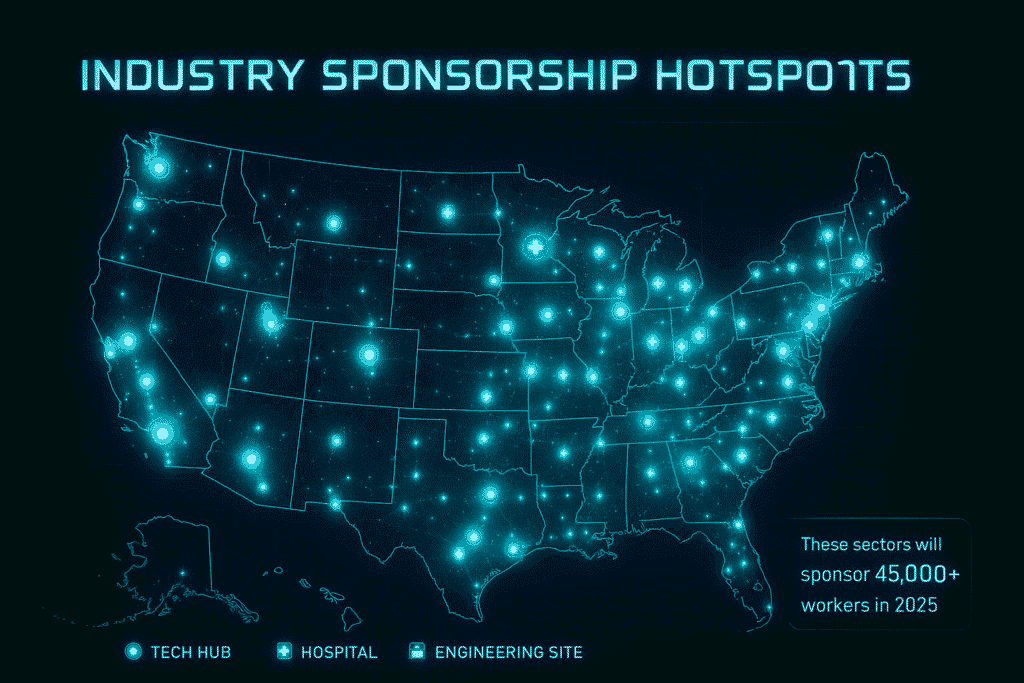
Technology: The Undisputed Leader in Sponsorship Opportunities
The U.S. technology industry continues to lead in green card sponsorship opportunities, with an insatiable appetite for specialized IT talent. Major tech hubs like Silicon Valley, Seattle, and Austin are actively recruiting global professionals to fill critical gaps in their workforces.
Software development roles remain the most sought-after, particularly for experts in emerging fields like artificial intelligence and machine learning. Data scientists who can transform complex information into actionable business insights are finding particularly strong sponsorship opportunities, with salaries often exceeding $150,000 for qualified candidates.
The cybersecurity field has seen explosive growth, with companies scrambling to protect their digital assets from increasingly sophisticated threats. Cloud computing specialists are equally in demand as more businesses transition their infrastructure to platforms like AWS, Azure, and Google Cloud.
What makes tech such a reliable path to sponsorship? The U.S. graduates only about 65,000 computer science students annually while needing over 160,000 new tech workers each year. This massive gap ensures continued sponsorship opportunities for qualified international professionals.
Healthcare: America’s Growing Lifeline for Foreign Medical Talent
The U.S. healthcare system faces a perfect storm of factors driving unprecedented demand for medical professionals:
- An aging population—Baby boomers require more medical care as they enter their senior years.
- Lack of doctors in rural areas: In many places, there are less than 10 doctors for every 10,000 people.
- Specialized skill gaps—Certain medical specialties have critical shortages.
Registered nurses enjoy particularly strong prospects, with some hospitals offering signing bonuses up to $30,000 plus full green card sponsorship. Physicians specializing in family medicine, psychiatry, and geriatrics are finding excellent sponsorship opportunities, especially in underserved areas.
The pandemic accelerated trends in medical technology, creating new demand for specialists in:
- Telehealth systems
- Medical imaging technology
- Biomedical equipment innovation
The healthcare industry offers steady, long term sponsorship potential, as the Bureau of Labor Statistics projects that occupations in this sector will rise 13% between 2021 and 2031—much faster than the average.
Engineering & Construction: Rebuilding America’s Infrastructure
The $1.2 trillion Infrastructure Investment and Jobs Act has created massive demand for engineering talent across several specialties:
Civil engineers are needed to design and oversee:
- Bridge and highway repairs
- Water system upgrades
- Renewable energy projects
Mechanical engineers play crucial roles in:
- Advanced manufacturing initiatives
- HVAC system modernization
- Transportation equipment design
Electrical engineers are essential for:
- Smart grid technology
- EV charging infrastructure
- Telecommunications expansion
Many infrastructure projects include provisions requiring American workers, but the specialized nature of engineering roles often makes sponsorship necessary to fill these positions with qualified candidates.
Finance & Accounting: The Backbone of Business Growth
As U.S. businesses expand globally, they need financial professionals who understand international markets and regulations. Sponsorship opportunities are particularly strong for:
Financial analysts with expertise in
- Emerging markets
- Risk assessment
- Investment strategies
Certified public accountants specializing in:
- International tax law
- Mergers and acquisitions
- Forensic accounting
Auditors with experience in
- Regulatory compliance
- Fraud detection
- Financial system security
Major financial centers like New York, Chicago, and Charlotte actively sponsor foreign talent, especially those with multilingual capabilities and international business experience.
Education & Research: Cultivating Tomorrow’s Innovators
American universities and research institutions remain global leaders in academic sponsorship, particularly for:
University professors in
- STEM fields
- Economics
- Specialized languages
Research scientists working in
- Biotechnology
- Environmental science
- Artificial intelligence
Postdoctoral researchers in cutting-edge fields like
- Quantum computing
- Neuroscience
- Renewable energy
Many research positions at top institutions come with not just sponsorship but pathways to tenure-track positions and long-term academic careers in the U.S.
Job Market Trends for Green Card Sponsorship in 2025
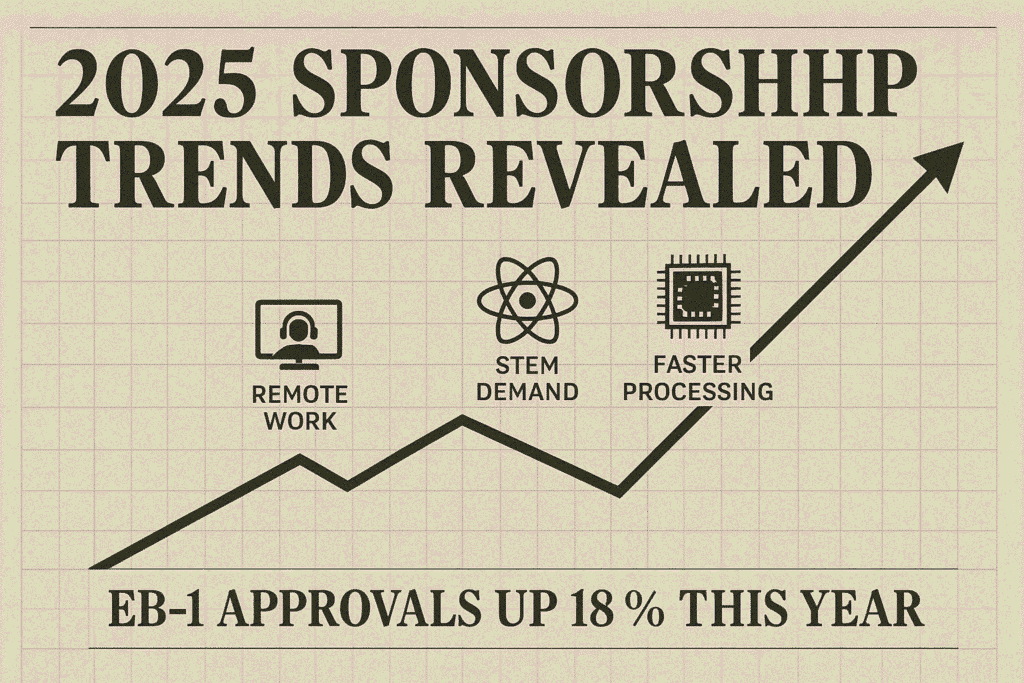
STEM Fields Continue Dominating Sponsorship Opportunities
The United States continues to face a critical shortage of qualified STEM professionals, creating exceptional green card sponsorship prospects for international talent. In 2025, we’re seeing particularly strong demand in emerging tech fields like quantum computing, artificial intelligence engineering, and biotechnology. The Department of Labor reports that STEM occupations are growing at nearly double the rate of non-STEM jobs, with computer-related positions alone projected to add over 600,000 new jobs by 2025.
What does this mean for applicants? Professionals with advanced degrees in these fields are increasingly bypassing the traditional H-1B lottery system entirely, going straight to EB-2 or even EB-1 green card sponsorship. Tech hubs like Silicon Valley, Seattle, and Boston are offering premium compensation packages that include full sponsorship processing, relocation bonuses, and accelerated visa processing through premium channels.
The Rise of “Try Before You Sponsor” Remote Hiring Models
A fascinating trend reshaping green card sponsorship is the growing acceptance of remote international hiring as a preliminary step. Forward-thinking companies are now:
- Hiring top global talent remotely on a contract basis
- Evaluating performance over 6-12 months
- Then initiating full green card sponsorship for standouts
This approach benefits both employers and applicants. Companies reduce sponsorship risks by verifying skills and cultural fit first, while professionals get a foot in the American job market without immediate visa pressures. We’re seeing this model used heavily in software development, digital marketing, and financial analysis roles where remote work is well-established.
Priority Processing Creates Fast-Track Options for Elite Talent
The EB-1 and EB-2 categories now offer significantly faster processing times compared to previous years. USCIS has implemented new premium processing options that can deliver approvals in as little as 15 calendar days for an additional fee. This is particularly valuable for:
- Researchers with high-impact publications
- Tech professionals holding patents
- Executives managing multinational teams
- Medical specialists in underserved areas
The key advantage? These categories often bypass the lengthy PERM labor certification process entirely. Applicants with strong evidence of extraordinary ability or advanced degrees paired with significant industry experience should seriously consider these pathways.
Tighter Labor Market Testing Requirements Change the Game
Recent policy changes have made the sponsorship process more rigorous for employers. Companies must now:
- Advertise positions across multiple platforms for longer durations.
- Document all applicant rejections in detail.
- Prove why each American applicant was unqualified.
- Submit comprehensive prevailing wage documentation.
While this creates more paperwork, it actually benefits qualified international professionals by:
- Ensuring only legitimate sponsorship cases proceed
- Preventing wage suppression tactics
- Validating that your skills are truly in demand
- Creating more transparent hiring processes
Applicants should be prepared for longer lead times but can take comfort knowing these changes ultimately protect foreign workers’ rights and ensure fair compensation.
How Employers Sponsor Green Cards
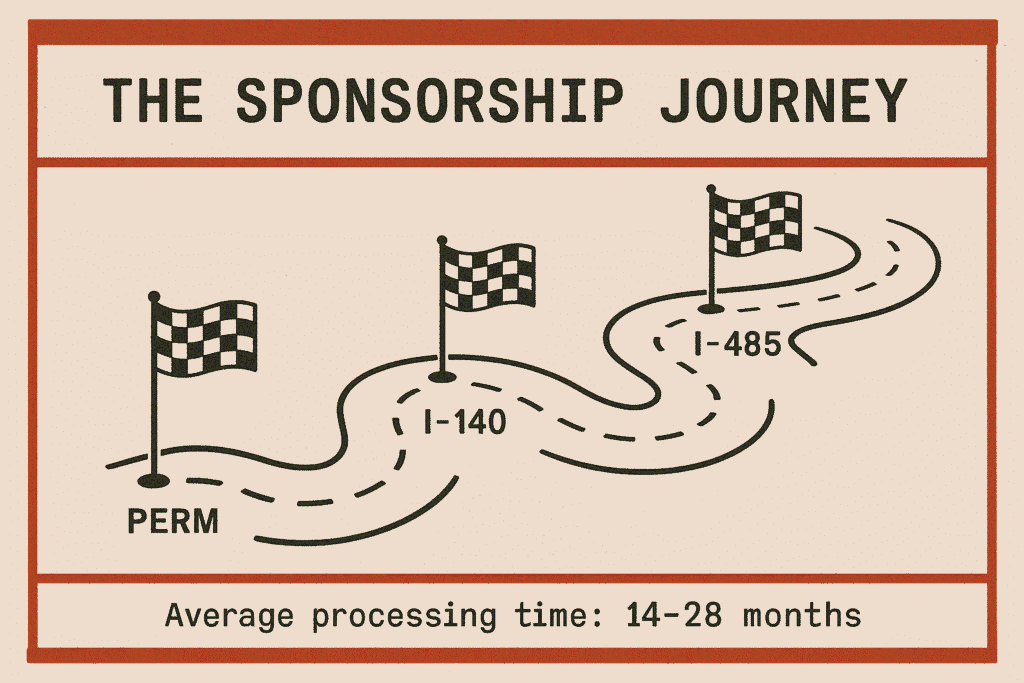
Step 1: The PERM Labor Certification—Proving American Workers Aren’t Available
The PERM (Program Electronic Review Management) labor certification procedure is the first step in the sponsorship process. This crucial first step requires employers to demonstrate they’ve made genuine efforts to recruit qualified American workers before turning to international talent.
The process involves several meticulous stages:
- Prevailing Wage Determination: Employers must first obtain an official wage determination from the Department of Labor, establishing the fair market rate for the position in that geographic area. This ensures foreign workers aren’t being used to undercut local wages.
- Mandatory Recruitment Activities: Companies are required to conduct extensive recruitment, including:
- Posting the job on the state workforce agency website for 30 days
- Running Sunday newspaper classified ads (in certain cases)
- Posting the job on additional job boards and the corporate website
- Considering internal candidates through normal HR channels
- Documenting Recruitment Results: Employers must maintain detailed records of all applicants, interviews conducted, and legitimate business reasons why American candidates weren’t selected. This documentation can be audited for up to five years after filing.
The entire PERM process typically takes 6-12 months to complete and serves as the foundation for all employment-based green card applications (except EB-1 and some EB-2 cases).
Step 2: Filing Form I-140—The Official Immigrant Petition
Once PERM approval is secured (or waived for certain categories), the employer files Form I-140, the Immigrant Petition for Alien Worker. This critical document serves three key purposes:
- Establishes the Employer-Employee Relationship: The petition demonstrates the company’s legitimate need for the worker’s specific skills and qualifications.
- Validates the Worker’s Qualifications: Through supporting documentation like:
- Diplomas and academic credentials
- Professional licenses or certifications
- Letters of recommendation
- Evidence of specialized experience
- Determines Priority Date: The I-140 filing date becomes the applicant’s “place in line” for visa numbers, which is especially important for categories with annual caps.
Premium processing is available for an additional $2,500 fee, which guarantees USCIS will adjudicate the petition within 15 calendar days—a valuable option for those needing faster decisions.
Step 3: The Final Hurdle—Adjustment of Status or Consular Processing
The last phase differs depending on where the applicant is currently located:
For Those Already in the U.S.:
- To change your status to permanent resident, submit Form I-485.
- Attend biometrics appointment for fingerprinting and photos.
- Complete a medical examination with a USCIS-approved physician.
- Attend final green card interview at local USCIS office
For Applicants Outside the U.S.:
- Case transfers to the National Visa Center (NVC) for processing
- Fill out the DS-260 application for an immigrant visa and submit civil documents.
- Undergo medical examination at approved clinic in home country
- Attend visa interview at U.S. embassy or consulate
Current processing times vary significantly by location and visa category, ranging from 10 months to several years in backlogged categories. Applicants can check case status online through the USCIS Case Status tool.
Steps to Find Green Card Sponsorship Jobs in the USA
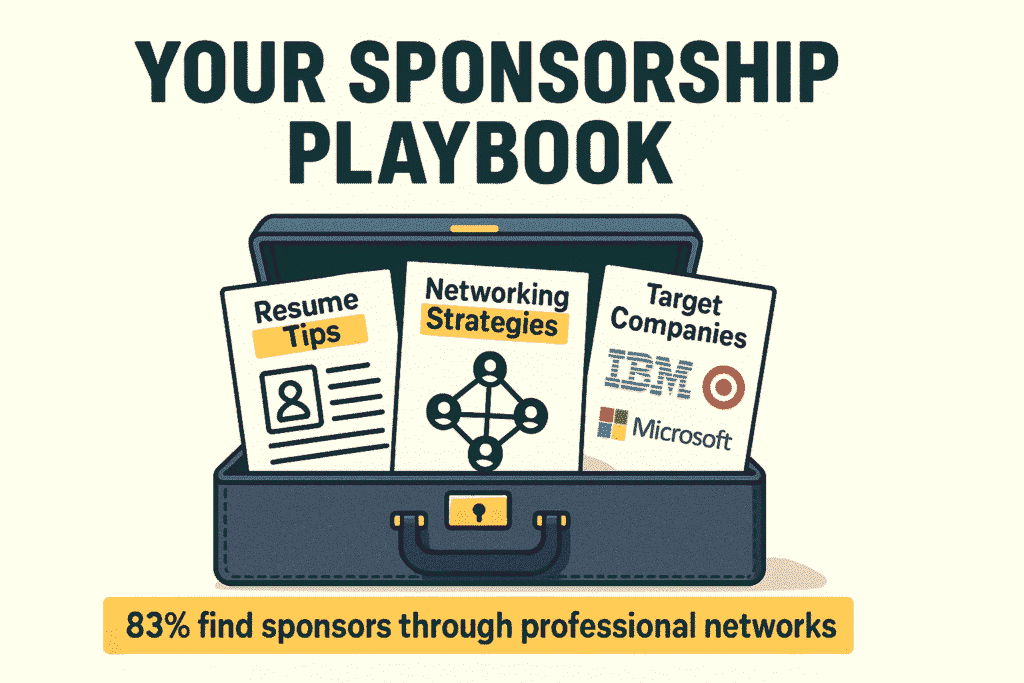
1. Mastering the American-Style Resume: Your First Impression Counts
Crafting a resume that resonates with U.S. hiring managers requires more than just translating your current CV. American employers expect:
- A skills-first approach that immediately demonstrates your value proposition
- Quantifiable achievements rather than just job descriptions (e.g., “Increased system efficiency by 40%”)
- Cultural alignment through proper formatting and terminology
- Keyword optimization for applicant tracking systems (ATS) used by 98% of large companies
Pro Tip: Include a “Visa Status” section that clearly states your need for sponsorship while emphasizing your unique qualifications that justify the employer’s investment.
2. Navigating Specialized Job Platforms for Sponsorship Opportunities
While mainstream job sites can be useful, these specialized platforms yield better results for sponsorship seekers:
LinkedIn:
- Use the “Sponsorship” filter in job searches.
- Join groups such as “Green Card Sponsorship & H1B Visa Jobs.”
- Optimize your profile with sponsorship-related keywords.
MyVisaJobs:
- Tracks companies with approved labor certifications
- Provides salary data for prevailing wage requirements
- Lists employers by sponsorship frequency
Indeed:
- Search using terms like “visa sponsorship” or “green card sponsorship.”
- Set up job alerts for new sponsorship postings.
- Research company sponsorship histories.
Industry-Specific Boards:
- Dice (for tech professionals)
- HospitalCareers (for healthcare workers)
- EngineeringJobs (for engineers)
3. Strategic Networking: Building Relationships That Lead to Sponsorship
Passive job applications have a 1-3% success rate for sponsorship roles. Using a proactive networking strategy significantly improves your chances:
Professional Associations:
- Join organizations like IEEE (tech), AMA (medical), or ASCE (engineering).
- Attend chapter meetings and national conferences.
- Volunteer for committees to increase visibility.
Alumni Networks:
- Connect with graduates from your university working in the U.S.
- Attend alumni events in your target cities.
- Leverage your alma mater’s career services.
Informational Interviews:
- Request 15-minute Zoom calls with professionals at target companies.
- Focus on learning about their work rather than asking for jobs.
- Follow up with thank-you notes and periodic updates.
4. Targeting the Right Employers: Where Sponsorship Happens
Focus your efforts on companies with proven sponsorship track records.
Tech Industry Leaders:
- FAANG companies (Facebook/Meta, Apple, Amazon, Netflix, Google)
- Major consulting firms (Accenture, Deloitte, IBM)
- Growing startups in AI, cybersecurity, and cloud computing
Healthcare Systems:
- Major hospital chains like HCA Healthcare and Kaiser Permanente
- Rural healthcare providers with critical staffing needs
- Research institutions like Mayo Clinic and Cleveland Clinic
Engineering Powerhouses:
- Infrastructure firms involved in IIJA-funded projects
- Aerospace and defense contractors
- Renewable energy companies expanding operations
Pro Tip: Review a company’s recent PERM certifications on the Office of Foreign Labor Certification website to confirm their active sponsorship history.
Challenges and Solutions in Securing Sponsorship
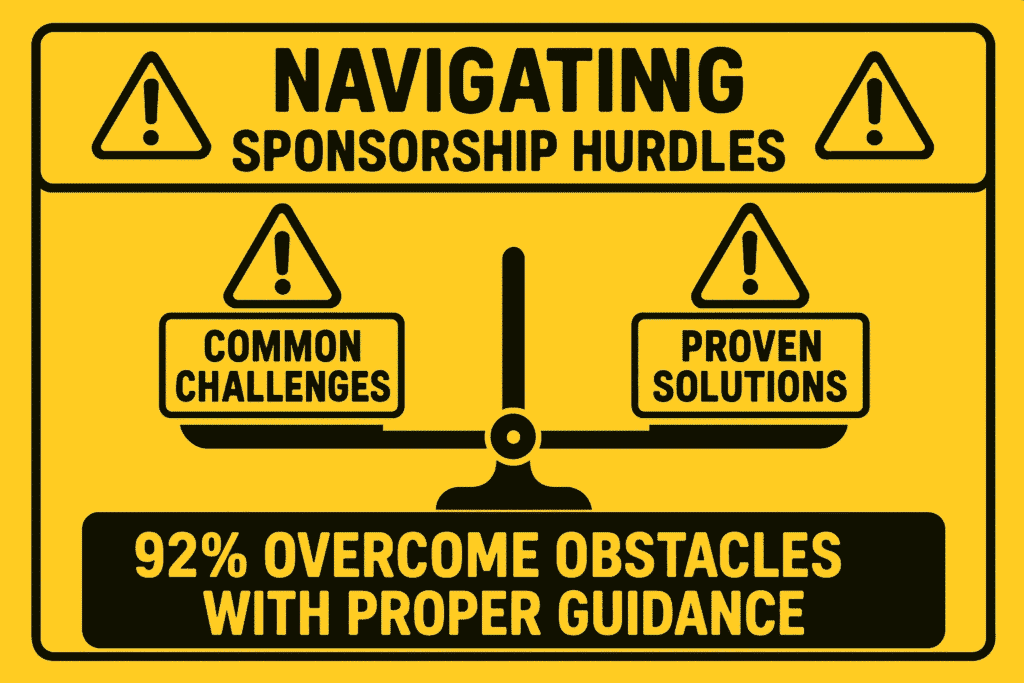
The path to securing an employer-sponsored green card has become increasingly competitive, with some major tech companies receiving thousands of applications for a single sponsored position. This intense competition stems from several factors:
- Limited Annual Caps: Only 140,000 employment-based green cards are issued each year across all categories.
- Country-Specific Quotas: No single country can receive more than 7% of the total, creating backlogs for high-demand nations.
- Employer Selectivity: Companies often reserve sponsorship for truly exceptional candidates who offer unique skills.
What many applicants don’t realize is that competition varies dramatically by
- Geographic location (with non-coastal states often having less competition)
- Industry specialization (niche skills face less competition)
- Company size (smaller firms may have fewer applicants)
The Waiting Game: Understanding Processing Time Realities
The sponsorship timeline can test even the most patient professionals. Current processing scenarios include
Standard Cases:
- PERM labor certification: 6-12 months
- I-140 petition: 6-18 months (or 15 days with premium processing)
- Visa availability wait: 1-10+ years depending on category and country
- Final adjudication: 6-24 months
Backlog Considerations:
- Indian EB-2/EB-3 applicants face decade-long waits.
- Chinese professionals experience 3-5 year delays.
- All other countries generally have shorter queues.
These extended timelines create career planning challenges, particularly for those on temporary visas approaching their maximum stay periods.
Why Many Employers Hesitate to Sponsor
Small and mid-sized companies often shy away from sponsorship due to legitimate concerns:
- Financial Burden: Sponsorship costs $5,000-$20,000 in legal/processing fees.
- Uncertain Outcomes: Applications can be denied after significant investment.
- Employee Mobility: Sponsored workers gain freedom to leave after green card approval.
- Administrative Complexity: Maintaining compliance requires dedicated HR resources.
This creates a paradox where the companies that most need specialized talent are often least able to sponsor it.
Proven Strategies to Overcome Sponsorship Hurdles
1. Positioning Yourself for EB-1 or EB-2 Eligibility
The “extraordinary ability” or “advanced degree” routes offer significant advantages:
- No PERM labor certification required
- Faster processing timelines (often under 2 years)
- No dependency on a specific employer after approval
Building an EB-1/EB-2-worthy profile requires
- Publishing in respected industry journals
- Securing patents or proprietary technologies
- Earning prestigious awards or recognitions
- Demonstrating significant media coverage of your work
- Showing high salary as evidence of exceptional ability
2. The Multinational Advantage
Global companies with U.S. operations offer unique pathways:
- L-1 intracompany transfers can lead to green card sponsorship.
- Employers in multinational corporations value international experience higher.
- Overseas assignments help build the “multinational executive” EB-1C qualification.
3. Targeting Sponsorship-Friendly Employers
Look for these positive indicators:
- Recent PERM approvals (search OFLC disclosure data)
- Dedicated immigration counsel on staff
- Public diversity statements emphasizing global talent
- Presence in industries with acute skill shortages
4. Alternative Pathways Worth Considering
When direct sponsorship proves difficult:
- The EB-5 investor program (minimum $800,000 investment)
- National Interest Waiver (NIW) for those benefiting the U.S. economy
- O-1 visa for extraordinary achievers as a stepping stone
The sponsorship journey requires patience, persistence, and strategic positioning. By understanding these challenges and implementing targeted solutions, international professionals can significantly improve their chances of securing that life-changing green card opportunity.
Alternative Visa Options for Jobs in the USA
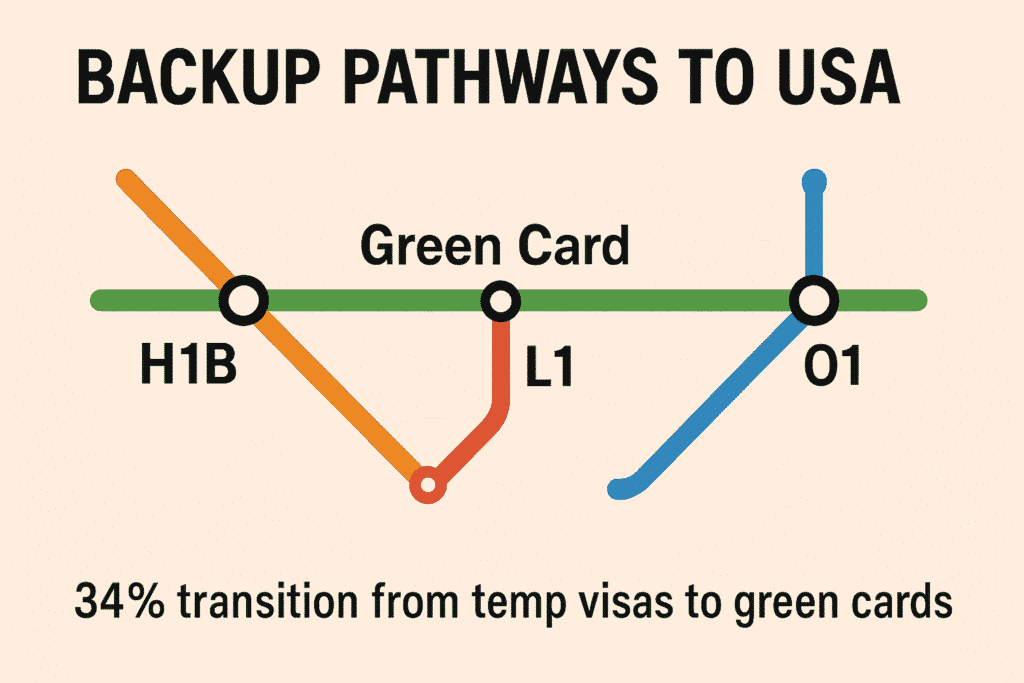
For many international professionals, the path to employer-sponsored green cards can feel dauntingly complex or frustratingly slow. The good news? Several alternative visa options can serve as valuable stepping stones to permanent residency while allowing you to work legally in the United States. Understanding these alternatives could mean the difference between abandoning your American dream and finding a creative pathway to achieve it.
1. The H-1B Visa: America’s Premier Work Visa for Specialty Occupations
The H-1B program remains the most accessible entry point for skilled foreign workers, particularly in technology, engineering, and specialty fields. Here’s what makes it unique:
- Duration: 3 years at first, with a 6-year extension possible
- Eligibility: Requires a bachelor’s degree or equivalent in a specialty occupation.
- Cap: 85,000 visas per year (65,000 normal + 20,000 exemptions for advanced degrees)
- Dual Intent: Allows for green card application while on H-1B status
Strategic Advantage: Many employers use the H-1B as a “trial period” before committing to green card sponsorship. Our comprehensive guide on Jobs in the USA for H1-B Visa Holders dives deeper into maximizing this opportunity.
2. The L-1 Visa: The Corporate Pathway for Multinational Employees
For professionals already working with international companies, the L-1 visa offers one of the most straightforward routes to U.S. employment:
- Two Categories:
- L-1A for managers/executives (valid up to 7 years)
- L-1B for specialized knowledge employees (valid up to 5 years)
- Key Benefits:
- No annual cap or lottery system
- Faster processing than H-1B
- Clear route for L-1A holders to obtain an EB-1C green card
Ideal Candidates: Employees being transferred from foreign offices of U.S. companies or international firms establishing U.S. operations.
3. The O-1 Visa: For Extraordinary Achievers Across All Fields
The O-1, sometimes referred to as the “genius visa,” honors people who have demonstrated exceptional talent or accomplishment:
- Broad Categories: sciences, arts, education, business, or athletics
- No Degree Requirement: Based on demonstrated extraordinary ability
- Flexibility: Can be self-sponsored through a U.S. agent
- Duration: Initially 3 years, with unlimited 1-year extensions
Success Factors: Applicants must provide extensive evidence of national or international recognition, such as major awards, published material about their work, or original contributions of major significance.
4. The E-2 Treaty Investor Visa: For Entrepreneurs and Investors
While not technically a work visa, the E-2 allows individuals to come to the U.S. to develop and direct their investment enterprises.
- Requirements:
- Substantial investment in a U.S. business
- Citizenship in a treaty country
- Intent to develop and direct the enterprise
- Advantages:
- No minimum investment amount (must be “substantial”)
- Can be renewed indefinitely
- Fast processing times
5. The TN Visa: Exclusive Benefit for Mexican and Canadian Professionals
Under NAFTA (now USMCA), qualified Canadian and Mexican citizens can access this unique work authorization:
- Covered Professions: Over 60 designated occupations
- Key Features:
- No annual cap
- Easier processing than H-1B
- Initial 3-year period, renewable indefinitely
Important Note: Unlike H-1B, TN is not a dual-intent visa, which can complicate future green card applications.
Choosing the Right Pathway: Strategic Considerations
When evaluating alternatives to green card sponsorship:
- Assess Your Long-Term Goals: Some visas offer clearer paths to permanent residency than others.
- Understand Processing Times: Some options can get you working in the U.S. within months.
- Consider Your Qualifications: Each visa has unique requirements that may favor certain profiles.
- Evaluate Employer Flexibility: Some visas offer more job mobility than others.
For those needing to establish U.S. employment quickly while pursuing permanent residency, our guide on How to Get a Work Visa for Jobs in the USA provides a detailed comparison of all major visa categories, processing timelines, and success strategies.
Remember: Many successful immigrants have used these temporary visas as stepping stones to eventual green card sponsorship. The secret is to keep the end objective of permanent residency in mind while selecting the option that most closely matches your skills, schedule, and career goals.
Conclusion
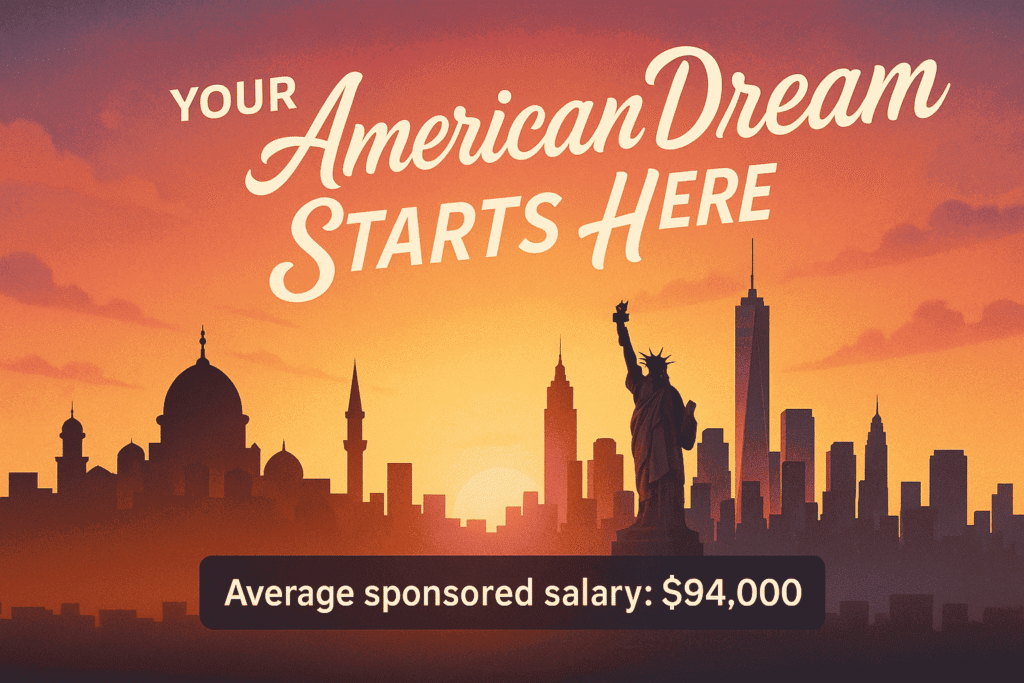
As we’ve explored throughout this comprehensive guide, securing green card sponsorship employment in the United States requires equal parts preparation, patience, and strategic action. The 2025 job market presents both exciting opportunities and unique challenges for international professionals seeking permanent residency through employment.
Successful applicants typically share three common traits:
- Deep understanding of industry demands in high-sponsorship sectors like technology, healthcare, and engineering
- Strategic career positioning that makes them irresistible to potential sponsors
- Persistent, informed approach to navigating the complex immigration process
Why This Journey Matters More Than Ever
In today’s competitive global economy, a U.S. green card represents more than just work authorization—it’s a transformative life opportunity that offers:
- Career stability beyond the limitations of temporary visas
- Family security through the ability to sponsor loved ones
- Financial opportunities, including access to better loans and investments
- Long-term freedom to pursue your professional and personal aspirations
Continuing Your Immigration Journey
While this guide has focused on green card sponsorship, we understand every professional’s path is unique. For those needing alternative routes or interim solutions, we’ve created detailed resources to support your journey:
1. How to Get a Work Visa for Jobs in the USA
A step-by-step guide to temporary work authorization options that can serve as bridges to permanent residency. This resource is particularly valuable for professionals who need to establish U.S. employment quickly while pursuing long-term sponsorship opportunities.
2. Jobs in the USA for H1-B Visa Holders
Specialized advice for technology professionals and others navigating the H1-B system, including strategies to transition from temporary to permanent status.
Final Words of Encouragement
The path to U.S. permanent residency through employment sponsorship is rarely easy, but for those willing to invest the time and effort, the rewards can be life-changing. As you move forward:
- Stay informed about changing immigration policies.
- Continuously enhance your professional qualifications.
- Build meaningful connections in your industry.
- Remain persistent in pursuing your goals.
Remember, thousands of professionals successfully navigate this process each year—with the right approach and preparation, you could be among them. Your American dream may be closer than you think.
FAQs
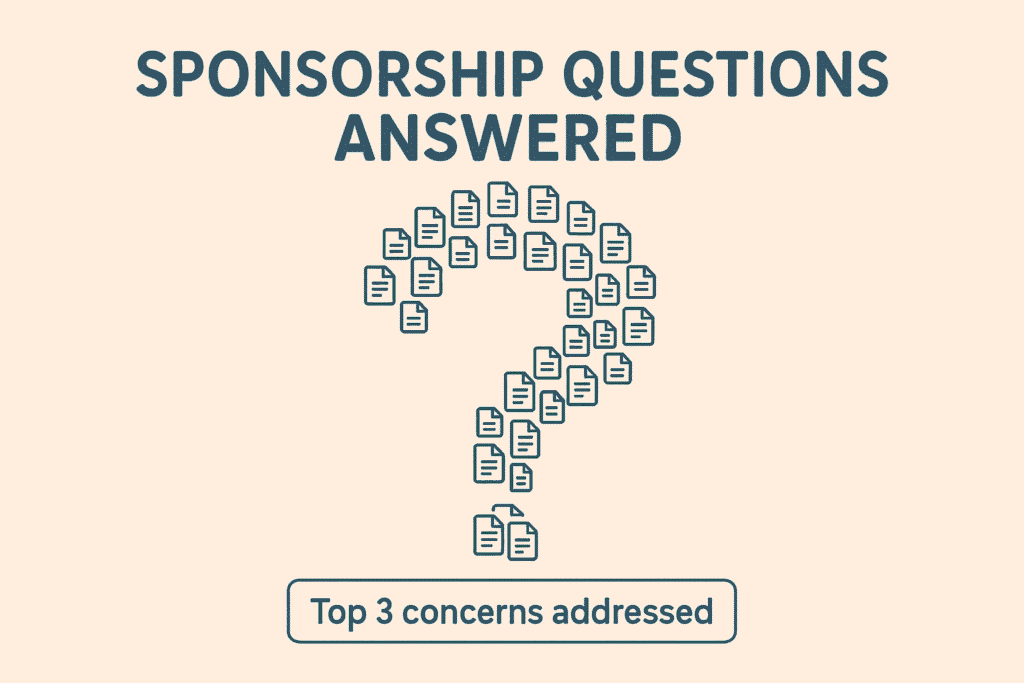
1. Which Companies Are Most Likely to Sponsor Green Cards?
Major sponsors typically fall into these categories:
- Tech Giants: Sponsorship lists are frequently topped by Amazon, Microsoft, Google, Apple, and Facebook/Meta.
- Global Consulting Firms: Deloitte, Accenture, and IBM have established sponsorship programs.
- Healthcare Systems: Major hospital chains like HCA Healthcare and Kaiser Permanente
- Engineering Firms: Companies involved in infrastructure projects and defense contracting
- Financial Institutions: JPMorgan Chase, Goldman Sachs, and other Wall Street firms
You can research specific companies’ sponsorship histories using the U.S. The Foreign Labor Certification Data Center of the Department of Labor.
2. What’s the Typical Timeline for Employment-Based Green Card Sponsorship?
Processing times vary significantly.
- EB-1 (Priority Workers): 8-14 months with premium processing
- EB-2 (Advanced Degrees): 1-3 years depending on country of origin
- EB-3 (Skilled Workers): 2-5 years for most applicants
- Backlog Countries: Indian applicants for EB-2 and EB-3 may have to wait more than ten years.
3. Can I self-sponsor for an employment green card?
Yes, in limited circumstances:
- EB-1A for extraordinary ability applicants
- For people whose labor benefits the United States, there is the EB-2 National Interest Waiver.
- EB-5 through qualifying investments
4. How Much Does Green Card Sponsorship Cost Employers?
Typical costs range $20,000, including
- Legal fees ($3,000-$10,000)
- Government filing fees ($1,500-$5,000)
- Recruitment costs ($500-$2,000)
- Premium processing fees ($2,500 when applicable)
5. What’s the Difference Between PERM and Non-PERM Green Card Processes?
PERM-Required (EB-2/EB-3):
- Mandatory labor market testing
- 6-12 month recruitment process
- Must prove no qualified U.S. workers are available.
Non-PERM (EB-1/EB-2 NIW):
- No labor certification
- Faster processing
- Based on individual merits rather than employer need
6. Can I Change Jobs During Green Card Processing?
This depends on your stage:
- Before I-140 Approval: Generally must stay with sponsoring employer
- After I-140 Approval (180+ days): Can use AC21 portability rules
- After I-485 Pending (180+ days): Greater flexibility to change jobs
7. What Happens If My Green Card Application Is Denied?
Options may include:
- Re-filing with additional evidence
- Appealing the decision
- Exploring alternative visa options
- Consider consular processing if currently abroad.
8. How Does the Priority Date System Work?
Key points:
- Your “place in line” is set when I-140 is filed.
- The Visa Bulletin shows current processing dates.
- You must wait until your priority date is current to file I-485.
- Dates move unpredictably based on demand.
9. Can My Family Come With Me During the Process?
Yes, through:
- Derivative visas for spouses/children
- Work authorization for spouses (EAD)
- Eventually family-based green cards
10. What Are the Medical Examination Requirements?
All applicants must:
- Use a USCIS-approved physician.
- Complete required vaccinations.
- Undergo TB testing
- Disclose medical history.
- Pay $200-$500 in exam fees.
11. How Important Is My Degree From Outside the U.S.?
Foreign degrees are acceptable, but
- May require credential evaluation
- Must be equivalent to U.S. degrees
- Some fields require specific accreditation.
- Work experience can sometimes substitute
12. What’s the Best Strategy for Nurses Seeking Sponsorship?
Recommended approach:
- Target hospitals in underserved areas.
- Obtain NCLEX and state licensing first.
- Consider EB-3 or Schedule A designation.
- Be open to rural locations initially.
13. Can startup companies sponsor green cards?
Yes, but challenges include:
- Proving financial stability
- Demonstrating ability to pay prevailing wage
- Limited resources for legal processes
- Higher scrutiny of applications
14. How Does the Public Charge Rule Affect Applications?
Current considerations:
- Must show sufficient financial resources
- Health insurance is recommended.
- Certain public benefits may cause issues.
- Assets and education level are factors.
15. What Are Common Reasons for Sponsorship Denials?
Frequent issues include:
- Incomplete documentation
- Failure to meet job requirements
- Inability to pay prevailing wage
- Errors in PERM recruitment
- Criminal or immigration violations


